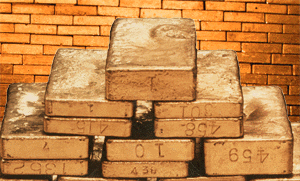Gold Bullion and the Gold Standard
To meet its needs for qualified employees, in 1919 National City Bank prepared a correspondence course entitled Foreign Exchange and International Banking, National City Bank Educational Series, New York. Other contemporary texts are also quoted.
Mint Parities Where two countries have the same metallic standard, and where the standard is fully maintained it is obvious that the monetary units must bear the same relation to each other as obtains between their respective bullion equivalents. For example: If a dollar is equal in value to 23.22 grains of gold; and if the pound sterling is equal in value to 112.997 grs. of gold; then the dollar must bear the relation to a pound sterling that 23.22 grains of gold bears to 112.997 grains. But 112.997 is just 4.8665 times 23.22 hence the pound sterling is said to be equal to $4.8665. This is what is meant by "mint par." It is simply the expression of the relationship, determined by bullion equivalents, that obtains between two money units based upon the same standard. It is about the "mint par" that foreign exchange rates fluctuate.2 Mint par is not in any case a normal price toward which market forces are always trying to pull exchange rates. It is simply the level from which the so-called "gold points" are measured. . . . In buying foreign exchange you are simply buying the money, or the equivalent of the money, of a foreign country. If such country has the gold standard you can obtain funds there by shipping gold and by presenting such gold for coinage at the mint price, which is always a fixed price. Hence if you are buying funds through the purchase of exchange you will not pay a price higher than the amount it would cost you to get and ship gold. In like manner if you were selling foreign exchange you would not take a lower price in your own money than you could get if you had gold shipped from abroad and then had the gold coined at your own country mints.3 Gold Points - The points above and below mint par at which points gold movements tend to begin are known as the gold points. The one above par when foreign exchange is quoted in terms of the domestic money is know as the "upper" or "export" point. The one below par is correspondingly known as the "lower" or "import" point. The gold points are not, however, fixed points. The margin between par and the gold points is made up of elements which are subject to fluctuation. They constitute all items involved in shipping gold. Under the gold standard it is assumed that gold can be freely obtained and freely minted without cost. Freight, insurance, packing charges, carting expenses and sometimes loss of interest must, however, be provided for, and the gold will not normally be shipped unless the return will fully compensate these expenses. But all these expenses may change from time to time.4 | |
FOOTNOTES1Foreign Exchange and International Banking, The National City Bank Educational Series, 1919, Division II, Paper 3, pg 5. | |
| . . | |

